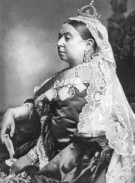Victoria Sponge Cake
21/07/2012 16:25
The Victoria sponge is the quintessential English cake, conjuring up images of old England and afternoon tea.
The Victoria sandwich, as it is also known, was named after Queen Victoria of Great Britain who favoured a slice of the sponge cake with her afternoon tea. The cake seems to have first come on the scene after about a quarter of a century of her reign- the first known recipe for it is given in Mrs. Beeton's Book of Household Management (1861).
A 'sandwich' cake is a sponge cake consisting of a layer of filling, such as cream or jam, sandwiched between two layers of sponge and the top is usually dusted with sugar.

VICTORIA SPONGE
Perfect with afternoon tea
~ Serves 8
2x 8 inch (20 cm) round cake tins
175g / 6oz butter, softened
175g / 6oz caster sugar
175g / 6oz self -raising flour
3 eggs, beaten
1 tsp vanilla extract
icing sugar, for dusting
Filling
85g butter, softened
175g icing sugar, sifted
2 tbsp raspberry jam
Heat the oven to 180°C/350F/ gas 4.
Grease the two sandwich tins and line the bases with greaseproof paper.
Cream together the butter and sugar until the mixture looks pale and fluffy.
Add the vanilla extract and gradually beat in the eggs, beating well between each addition. Sift in the flour and fold into the mixture.
Divide the mixture between the two tins and smooth over with a spatula. Pop into the centre of the oven and bake for 25 -30 minutes, or until firm to the touch, or a skewer comes out clean. Cool in the tins for 5 minutes, then remove and cool completely on a wire rack.
To make the filling, beat together the butter and icing sugar until creamy.
Spread the flat side of one of the sponges with the jam, and the other sponge with the buttercream. Now, 'Sandwich' them together. Dust the top with icing sugar and serve.
Tips ~ Make sure your oven is up to temperature - your cake will rise beautifully.
To stop the mixture curdling when you add the eggs, beat them in very slowly with a spoon. If the mixture does curdle, don't panic! Just stir in a little flour to smooth things out and then keep adding the egg to the mixture.
Afternoon Tea
Afternoon Tea is traditionally served between four and five in the afternoon- hence the name.
Many people believe that this tradition was first started in 1841 by Anna Maria Stanhope, the seventh Duchess of Bedford.
At that time, and in fact right up until the early decades of the 20th century, luncheon was served at twelve noon but dinner was not served until 8.00 or even 9.00pm in the evenings. This left quite a gap between mealtimes, so its said that the duchess began to request a cup of tea and light snacks to be served around 5 pm, and then she began to invite guests to join her.
A light lunch in the early afternoon was just the thing to fill the gap between breakfast and dinner, and so the custom of afternoon tea was born, it spread like wildfire among the upper classes. Ladies across the land who were 'at home' would dress elaborately in their finest dresses and visit each other's houses to partake of afternoon tea.
Traditionally, loose tea is brewed in a teapot and served in teacups with milk and sugar. This is accompanied by sandwiches, customarily cucumber, egg and cress, fish paste and ham (crusts removed, naturally!) scones were served with clotted cream and jam, and other cakes and pastries were served too, such as Battenberg, fruit cake and course a Victoria sponge cake. :)
"There are few hours in life more agreeable than the hour dedicated to the ceremony known as afternoon tea."
~ Henry James, The Portrait of a Lady